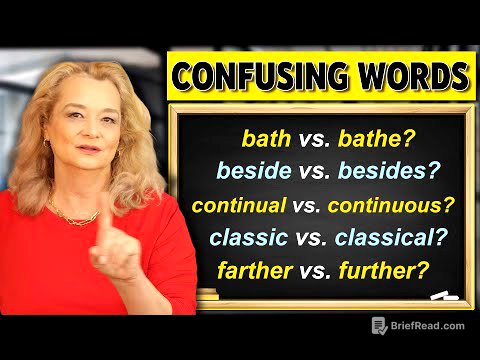TLDR;
This video provides a comprehensive overview of essential measurement concepts in chemistry, including physical quantities, accuracy and precision, significant figures, scientific notation, density measurement, and unit conversions. It emphasises the importance of understanding these concepts for success in general chemistry.
- Defines measurement and its components: magnitude and unit.
- Explains the difference between fundamental and derived quantities.
- Details the rules for significant figures and their application in calculations.
- Covers scientific notation for expressing large and small numbers.
- Illustrates density measurement and unit conversion using dimensional analysis.
Introduction to Measurement [0:06]
The video introduces key measurement topics necessary for general chemistry, including physical quantities, accuracy, precision, significant figures, scientific notation, density measurement and unit conversion. Measurement is defined as obtaining numerical values from experiments using measuring devices like rulers and weighing scales. Examples of measurements include stating a magnitude and choosing a unit, such as 5 kilograms for mass, 100 centimetres for length and 500 seconds for time.
Fundamental vs. Derived Quantities [1:07]
The discussion covers fundamental and derived quantities. There are seven fundamental quantities: mass (kilogram), length (metre), time (second), temperature (kelvin), luminous intensity (candela), electric current (ampere), and amount of substance (mole). Derived quantities, such as volume, density, weight, energy and pressure, are combinations of fundamental quantities. Volume is determined by multiplying length, width and height, illustrating how it combines three fundamental length units. Density is expressed as mass over volume, combining mass (a fundamental quantity) with volume (a derived quantity). Velocity, measured in metres per second, is the ratio of distance (length) over time, combining two fundamental quantities.
Common Prefixes in Measurement [4:22]
The video explains common prefixes used in measurements, such as kilo (1,000 times greater), hecto (100 times greater), deca (10 times), deci (10 times smaller), centi (100 times smaller), milli (1,000 times smaller) and micro (1,000,000 times smaller). Examples include 1 kilogram equalling 1,000 grams and 100 centimetres equalling 1 metre. The use of prefixes helps in scaling units for more convenient measurements.
Accuracy vs. Precision [6:18]
Accuracy refers to the closeness of a single measurement to the true value, while precision refers to the closeness of several measurements to each other. Using a ruler example, measurements of 1.55 inches, 1.9 inches and 1.97 inches are compared to a true value of 1.9 inches. The 1.9-inch measurement is the most accurate. Precision is determined by finding the average of the measurements (1.81 inches) and assessing how close each measurement is to this average. Percent error, calculated as the difference between the experimental and true values divided by the true value, indicates accuracy; smaller errors suggest greater accuracy.
Significant Figures [10:53]
Significant figures are the digits in a measurement known precisely, plus one estimated digit. When measuring with a ruler, if a length falls between 1.5 and 1.6 inches, the measurement might be recorded as 1.55 inches, where 1 and 5 are precise, and the last 5 is estimated. The rules for significant figures include: all non-zero digits are significant; leading zeros are not significant; confined zeros are always significant; and trailing zeros are not significant unless there is a decimal point. Examples illustrate these rules, such as 0.00231 having three significant figures and 987,231 having nine significant figures.
Significant Figures in Calculations [19:01]
In addition and subtraction, the final answer should have the same number of decimal places as the measurement with the fewest decimal places. For example, adding 89.332 and 1.1, the answer is rounded to one decimal place, resulting in 90.4. In multiplication and division, the final answer should have the same number of significant figures as the measurement with the fewest significant figures. Multiplying 2.8 (two significant figures) by 4.5039 (five significant figures), the answer is rounded to two significant figures, resulting in 13.
Scientific Notation [23:10]
Scientific notation is used to express very large or small numbers conveniently. For large numbers, the decimal point is moved to the left until there is only one non-zero digit to the left of the decimal point, and the number is multiplied by 10 raised to the power of the number of places moved. For example, 987,654,231 can be expressed as 9.9 x 10^8 (two significant figures). For small numbers, the decimal point is moved to the right until after the first non-zero digit, and the number is multiplied by 10 raised to the negative power of the number of places moved. For example, 0.0000006 can be expressed as 6.0 x 10^-7 (two significant figures).
Density Measurement [26:39]
Density is defined as the ratio of mass to volume (d = m/v), with the SI unit being kilograms per cubic metre, though grams per cubic centimetre is commonly used. Examples of densities for various substances are provided. To calculate density, the mass of an object is divided by its volume. For instance, if a piece of gold weighs 301 grams and has a volume of 15.6 cubic centimetres, its density is calculated as 19.3 grams per cubic centimetre.
Unit Conversion [30:38]
Conversion is the process of changing a unit of measurement from one form to another, such as kilograms to grams or centimetres to metres. Dimensional analysis, or the factor label method, is used to convert units by multiplying the given quantity by a conversion factor derived from an equivalent relationship between two quantities. For example, to convert 2.46 dollars to pennies, knowing that 1 dollar equals 100 pennies, the conversion factor is 100 pennies/1 dollar, resulting in 246 pennies. Another example is converting 57.8 metres to centimetres using the equivalent relationship 1 centimetre = 0.01 metres, resulting in 5780 centimetres.









